Biology 112 Research Report: Common Diseases and Pathologies of Bone
VerifiedAdded on 2023/06/10
|9
|1644
|451
Report
AI Summary
This report provides an overview of common diseases, disorders, and pathologies related to the skeletal system. The introduction highlights the structure and function of bones. The report then delves into specific diseases, including osteoporosis, leukemia, and arthritis, discussing their causes, risk factors, signs, symptoms, and treatment options. Osteoporosis is described as a condition of decreased bone density and strength, leukemia as a malignancy of blood cells from bone marrow, and arthritis as a common joint disease. The report also mentions other bone-related diseases. The conclusion summarizes the importance of the skeleton and the various diseases that can affect it, emphasizing the symptoms, risk factors, and available treatments.
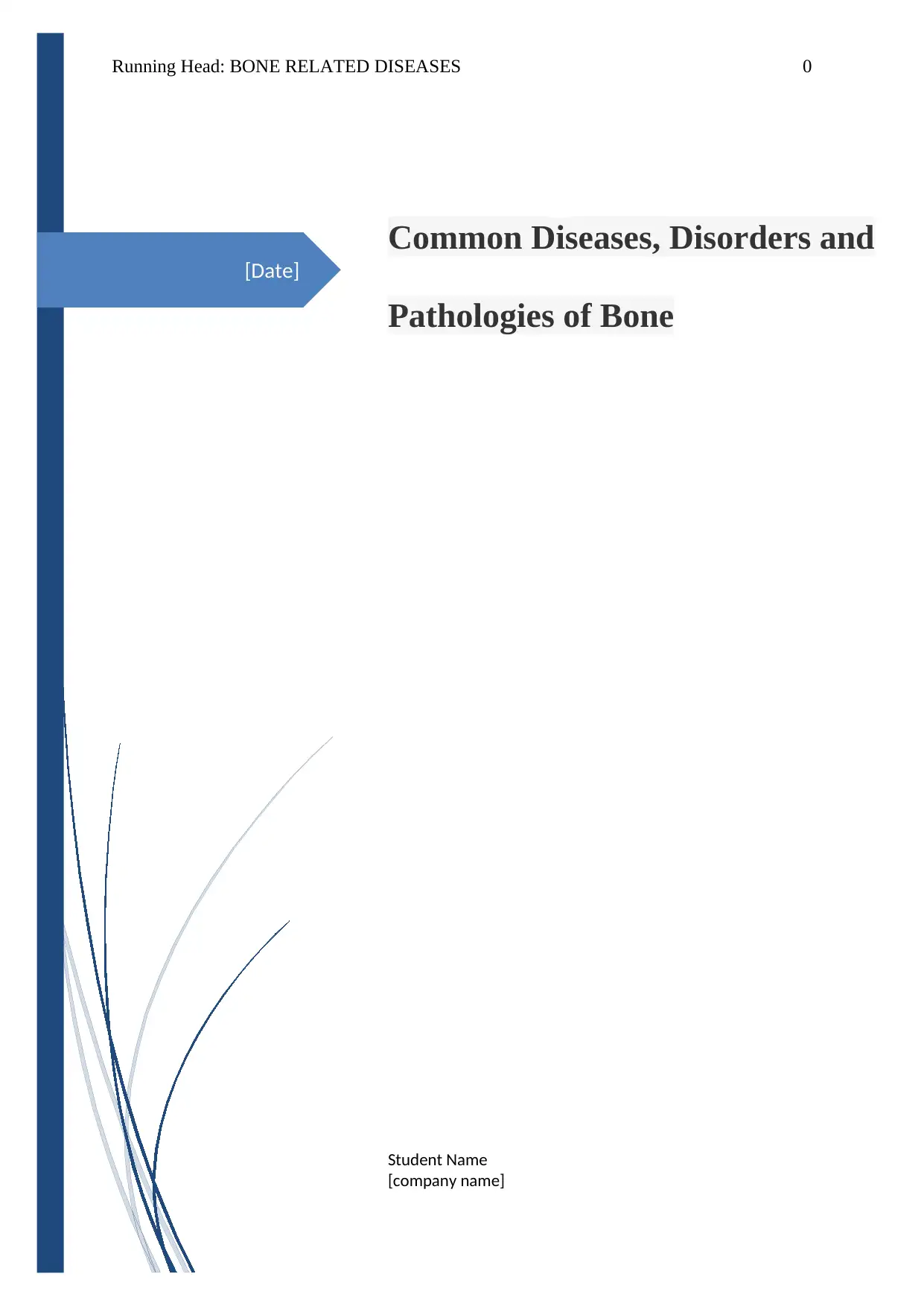
[Date]
Running Head: BONE RELATED DISEASES 0
Common Diseases, Disorders and
Pathologies of Bone
Student Name
[company name]
Running Head: BONE RELATED DISEASES 0
Common Diseases, Disorders and
Pathologies of Bone
Student Name
[company name]
Paraphrase This Document
Need a fresh take? Get an instant paraphrase of this document with our AI Paraphraser

BONE RELATED DISEASES 1
Table of Contents
Introduction................................................................................................................................1
Anatomy and physiology of Skeleton System.......................................................................1
Diseases of Skeleton system..................................................................................................2
Conclusion..................................................................................................................................5
References..................................................................................................................................6
Table of Contents
Introduction................................................................................................................................1
Anatomy and physiology of Skeleton System.......................................................................1
Diseases of Skeleton system..................................................................................................2
Conclusion..................................................................................................................................5
References..................................................................................................................................6
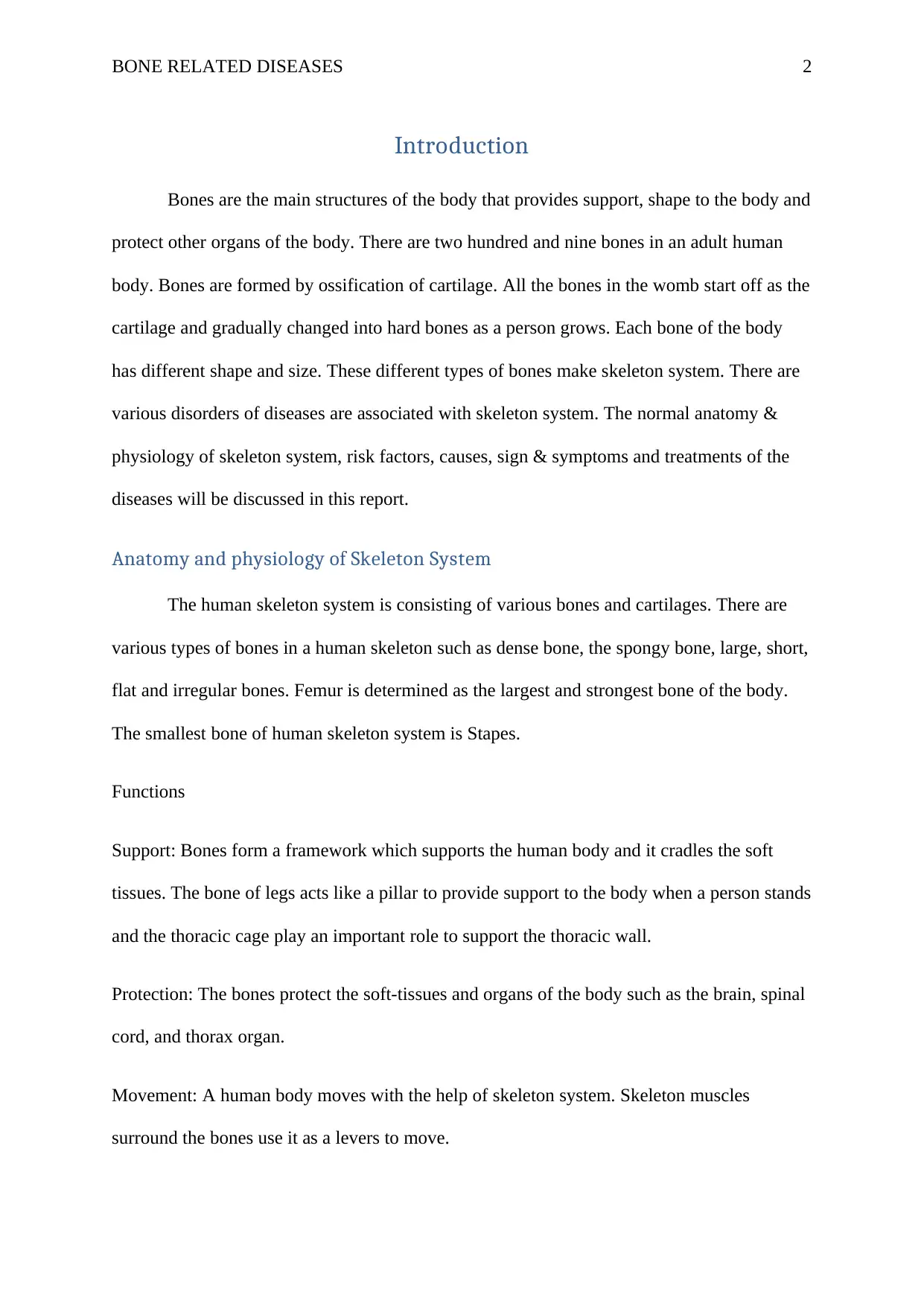
BONE RELATED DISEASES 2
Introduction
Bones are the main structures of the body that provides support, shape to the body and
protect other organs of the body. There are two hundred and nine bones in an adult human
body. Bones are formed by ossification of cartilage. All the bones in the womb start off as the
cartilage and gradually changed into hard bones as a person grows. Each bone of the body
has different shape and size. These different types of bones make skeleton system. There are
various disorders of diseases are associated with skeleton system. The normal anatomy &
physiology of skeleton system, risk factors, causes, sign & symptoms and treatments of the
diseases will be discussed in this report.
Anatomy and physiology of Skeleton System
The human skeleton system is consisting of various bones and cartilages. There are
various types of bones in a human skeleton such as dense bone, the spongy bone, large, short,
flat and irregular bones. Femur is determined as the largest and strongest bone of the body.
The smallest bone of human skeleton system is Stapes.
Functions
Support: Bones form a framework which supports the human body and it cradles the soft
tissues. The bone of legs acts like a pillar to provide support to the body when a person stands
and the thoracic cage play an important role to support the thoracic wall.
Protection: The bones protect the soft-tissues and organs of the body such as the brain, spinal
cord, and thorax organ.
Movement: A human body moves with the help of skeleton system. Skeleton muscles
surround the bones use it as a levers to move.
Introduction
Bones are the main structures of the body that provides support, shape to the body and
protect other organs of the body. There are two hundred and nine bones in an adult human
body. Bones are formed by ossification of cartilage. All the bones in the womb start off as the
cartilage and gradually changed into hard bones as a person grows. Each bone of the body
has different shape and size. These different types of bones make skeleton system. There are
various disorders of diseases are associated with skeleton system. The normal anatomy &
physiology of skeleton system, risk factors, causes, sign & symptoms and treatments of the
diseases will be discussed in this report.
Anatomy and physiology of Skeleton System
The human skeleton system is consisting of various bones and cartilages. There are
various types of bones in a human skeleton such as dense bone, the spongy bone, large, short,
flat and irregular bones. Femur is determined as the largest and strongest bone of the body.
The smallest bone of human skeleton system is Stapes.
Functions
Support: Bones form a framework which supports the human body and it cradles the soft
tissues. The bone of legs acts like a pillar to provide support to the body when a person stands
and the thoracic cage play an important role to support the thoracic wall.
Protection: The bones protect the soft-tissues and organs of the body such as the brain, spinal
cord, and thorax organ.
Movement: A human body moves with the help of skeleton system. Skeleton muscles
surround the bones use it as a levers to move.
⊘ This is a preview!⊘
Do you want full access?
Subscribe today to unlock all pages.

Trusted by 1+ million students worldwide
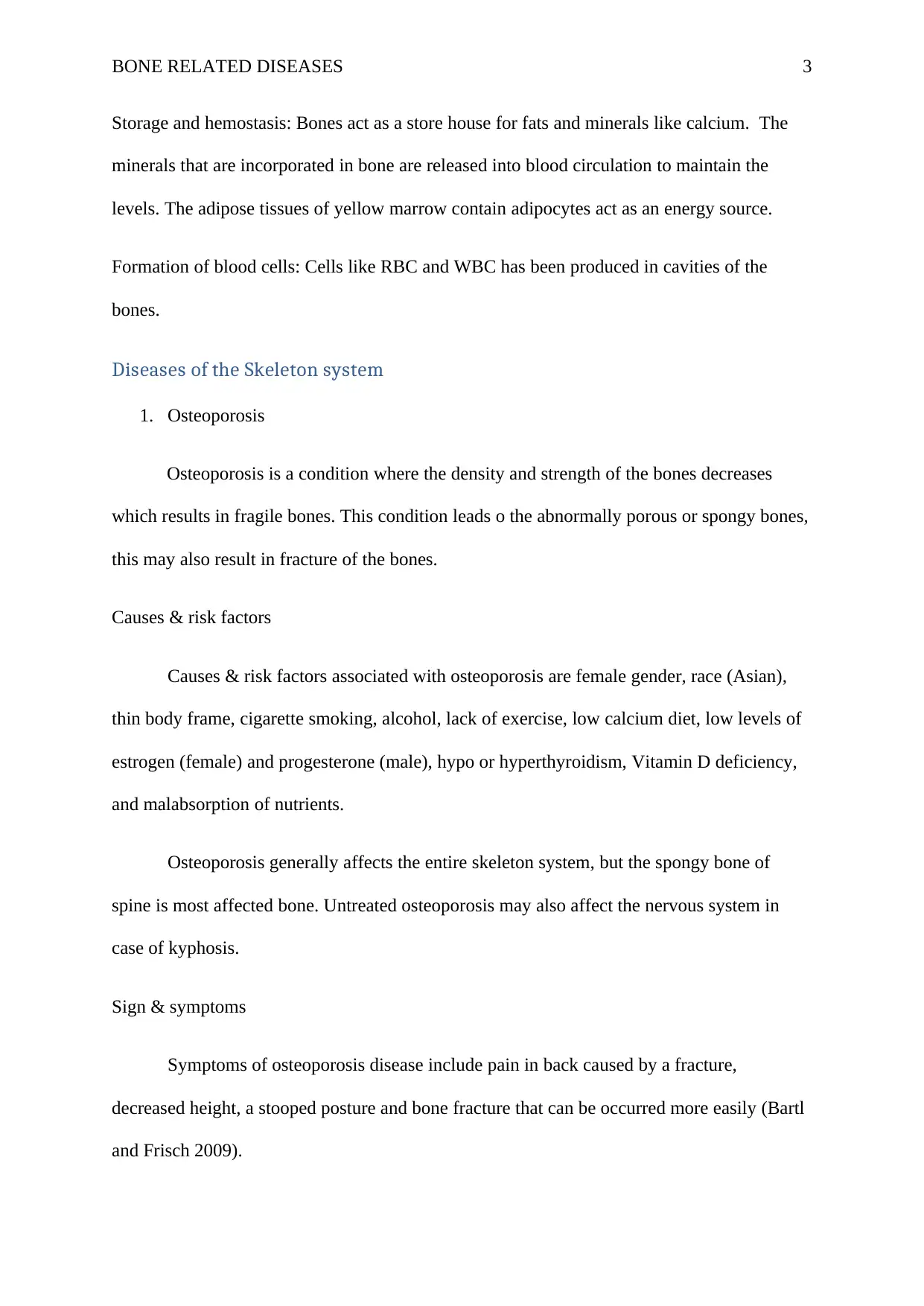
BONE RELATED DISEASES 3
Storage and hemostasis: Bones act as a store house for fats and minerals like calcium. The
minerals that are incorporated in bone are released into blood circulation to maintain the
levels. The adipose tissues of yellow marrow contain adipocytes act as an energy source.
Formation of blood cells: Cells like RBC and WBC has been produced in cavities of the
bones.
Diseases of the Skeleton system
1. Osteoporosis
Osteoporosis is a condition where the density and strength of the bones decreases
which results in fragile bones. This condition leads o the abnormally porous or spongy bones,
this may also result in fracture of the bones.
Causes & risk factors
Causes & risk factors associated with osteoporosis are female gender, race (Asian),
thin body frame, cigarette smoking, alcohol, lack of exercise, low calcium diet, low levels of
estrogen (female) and progesterone (male), hypo or hyperthyroidism, Vitamin D deficiency,
and malabsorption of nutrients.
Osteoporosis generally affects the entire skeleton system, but the spongy bone of
spine is most affected bone. Untreated osteoporosis may also affect the nervous system in
case of kyphosis.
Sign & symptoms
Symptoms of osteoporosis disease include pain in back caused by a fracture,
decreased height, a stooped posture and bone fracture that can be occurred more easily (Bartl
and Frisch 2009).
Storage and hemostasis: Bones act as a store house for fats and minerals like calcium. The
minerals that are incorporated in bone are released into blood circulation to maintain the
levels. The adipose tissues of yellow marrow contain adipocytes act as an energy source.
Formation of blood cells: Cells like RBC and WBC has been produced in cavities of the
bones.
Diseases of the Skeleton system
1. Osteoporosis
Osteoporosis is a condition where the density and strength of the bones decreases
which results in fragile bones. This condition leads o the abnormally porous or spongy bones,
this may also result in fracture of the bones.
Causes & risk factors
Causes & risk factors associated with osteoporosis are female gender, race (Asian),
thin body frame, cigarette smoking, alcohol, lack of exercise, low calcium diet, low levels of
estrogen (female) and progesterone (male), hypo or hyperthyroidism, Vitamin D deficiency,
and malabsorption of nutrients.
Osteoporosis generally affects the entire skeleton system, but the spongy bone of
spine is most affected bone. Untreated osteoporosis may also affect the nervous system in
case of kyphosis.
Sign & symptoms
Symptoms of osteoporosis disease include pain in back caused by a fracture,
decreased height, a stooped posture and bone fracture that can be occurred more easily (Bartl
and Frisch 2009).
Paraphrase This Document
Need a fresh take? Get an instant paraphrase of this document with our AI Paraphraser
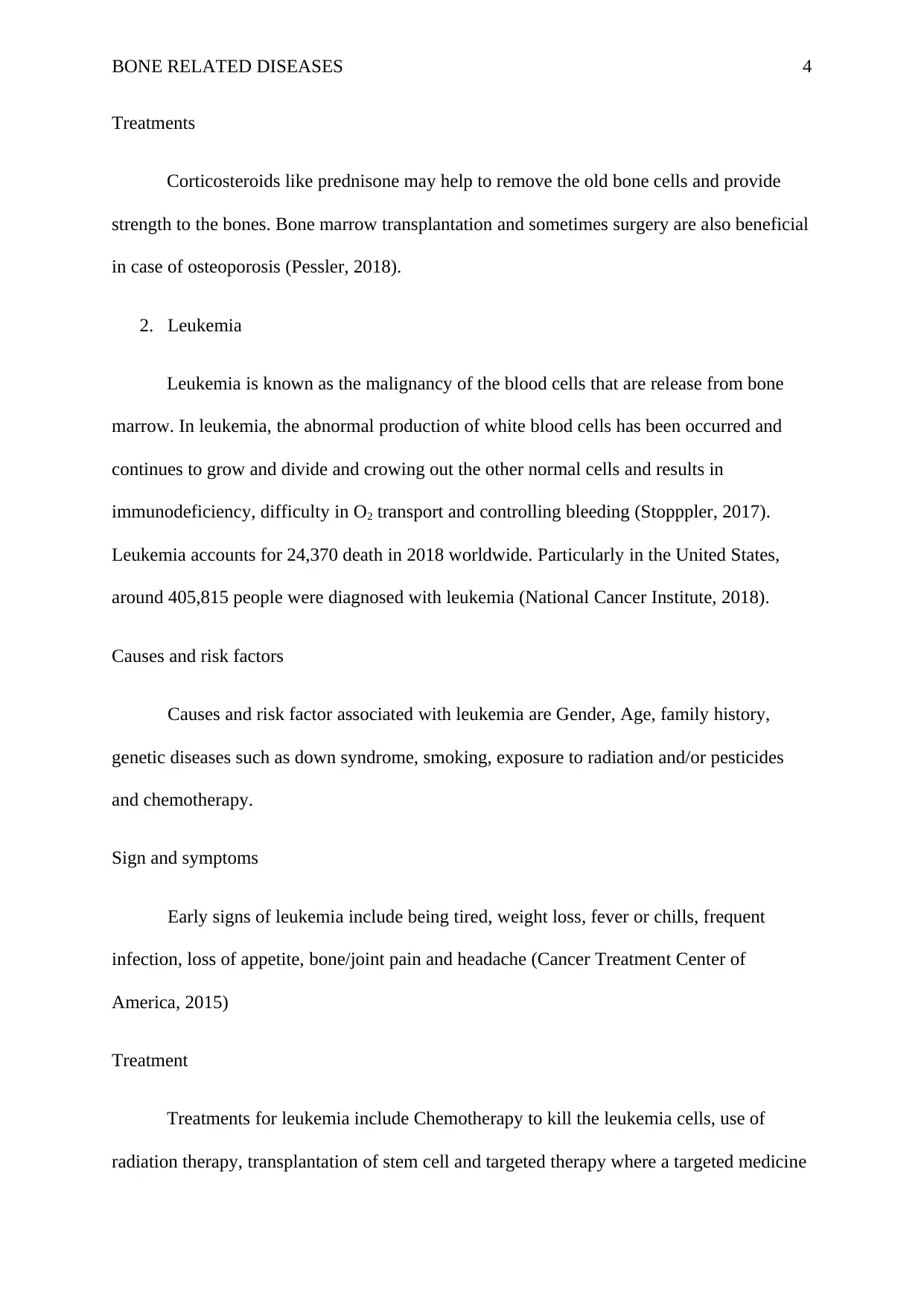
BONE RELATED DISEASES 4
Treatments
Corticosteroids like prednisone may help to remove the old bone cells and provide
strength to the bones. Bone marrow transplantation and sometimes surgery are also beneficial
in case of osteoporosis (Pessler, 2018).
2. Leukemia
Leukemia is known as the malignancy of the blood cells that are release from bone
marrow. In leukemia, the abnormal production of white blood cells has been occurred and
continues to grow and divide and crowing out the other normal cells and results in
immunodeficiency, difficulty in O2 transport and controlling bleeding (Stopppler, 2017).
Leukemia accounts for 24,370 death in 2018 worldwide. Particularly in the United States,
around 405,815 people were diagnosed with leukemia (National Cancer Institute, 2018).
Causes and risk factors
Causes and risk factor associated with leukemia are Gender, Age, family history,
genetic diseases such as down syndrome, smoking, exposure to radiation and/or pesticides
and chemotherapy.
Sign and symptoms
Early signs of leukemia include being tired, weight loss, fever or chills, frequent
infection, loss of appetite, bone/joint pain and headache (Cancer Treatment Center of
America, 2015)
Treatment
Treatments for leukemia include Chemotherapy to kill the leukemia cells, use of
radiation therapy, transplantation of stem cell and targeted therapy where a targeted medicine
Treatments
Corticosteroids like prednisone may help to remove the old bone cells and provide
strength to the bones. Bone marrow transplantation and sometimes surgery are also beneficial
in case of osteoporosis (Pessler, 2018).
2. Leukemia
Leukemia is known as the malignancy of the blood cells that are release from bone
marrow. In leukemia, the abnormal production of white blood cells has been occurred and
continues to grow and divide and crowing out the other normal cells and results in
immunodeficiency, difficulty in O2 transport and controlling bleeding (Stopppler, 2017).
Leukemia accounts for 24,370 death in 2018 worldwide. Particularly in the United States,
around 405,815 people were diagnosed with leukemia (National Cancer Institute, 2018).
Causes and risk factors
Causes and risk factor associated with leukemia are Gender, Age, family history,
genetic diseases such as down syndrome, smoking, exposure to radiation and/or pesticides
and chemotherapy.
Sign and symptoms
Early signs of leukemia include being tired, weight loss, fever or chills, frequent
infection, loss of appetite, bone/joint pain and headache (Cancer Treatment Center of
America, 2015)
Treatment
Treatments for leukemia include Chemotherapy to kill the leukemia cells, use of
radiation therapy, transplantation of stem cell and targeted therapy where a targeted medicine
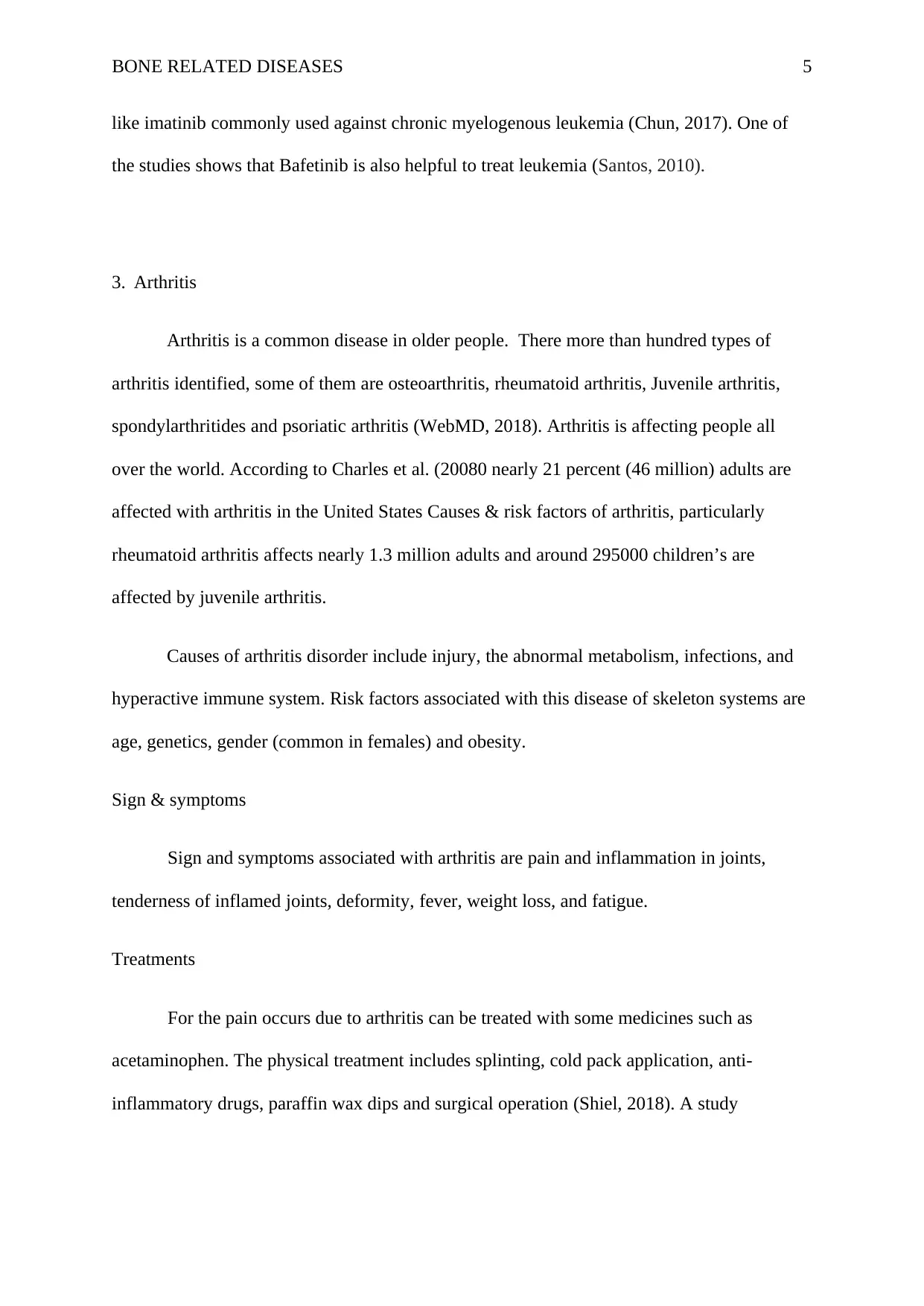
BONE RELATED DISEASES 5
like imatinib commonly used against chronic myelogenous leukemia (Chun, 2017). One of
the studies shows that Bafetinib is also helpful to treat leukemia (Santos, 2010).
3. Arthritis
Arthritis is a common disease in older people. There more than hundred types of
arthritis identified, some of them are osteoarthritis, rheumatoid arthritis, Juvenile arthritis,
spondylarthritides and psoriatic arthritis (WebMD, 2018). Arthritis is affecting people all
over the world. According to Charles et al. (20080 nearly 21 percent (46 million) adults are
affected with arthritis in the United States Causes & risk factors of arthritis, particularly
rheumatoid arthritis affects nearly 1.3 million adults and around 295000 children’s are
affected by juvenile arthritis.
Causes of arthritis disorder include injury, the abnormal metabolism, infections, and
hyperactive immune system. Risk factors associated with this disease of skeleton systems are
age, genetics, gender (common in females) and obesity.
Sign & symptoms
Sign and symptoms associated with arthritis are pain and inflammation in joints,
tenderness of inflamed joints, deformity, fever, weight loss, and fatigue.
Treatments
For the pain occurs due to arthritis can be treated with some medicines such as
acetaminophen. The physical treatment includes splinting, cold pack application, anti-
inflammatory drugs, paraffin wax dips and surgical operation (Shiel, 2018). A study
like imatinib commonly used against chronic myelogenous leukemia (Chun, 2017). One of
the studies shows that Bafetinib is also helpful to treat leukemia (Santos, 2010).
3. Arthritis
Arthritis is a common disease in older people. There more than hundred types of
arthritis identified, some of them are osteoarthritis, rheumatoid arthritis, Juvenile arthritis,
spondylarthritides and psoriatic arthritis (WebMD, 2018). Arthritis is affecting people all
over the world. According to Charles et al. (20080 nearly 21 percent (46 million) adults are
affected with arthritis in the United States Causes & risk factors of arthritis, particularly
rheumatoid arthritis affects nearly 1.3 million adults and around 295000 children’s are
affected by juvenile arthritis.
Causes of arthritis disorder include injury, the abnormal metabolism, infections, and
hyperactive immune system. Risk factors associated with this disease of skeleton systems are
age, genetics, gender (common in females) and obesity.
Sign & symptoms
Sign and symptoms associated with arthritis are pain and inflammation in joints,
tenderness of inflamed joints, deformity, fever, weight loss, and fatigue.
Treatments
For the pain occurs due to arthritis can be treated with some medicines such as
acetaminophen. The physical treatment includes splinting, cold pack application, anti-
inflammatory drugs, paraffin wax dips and surgical operation (Shiel, 2018). A study
⊘ This is a preview!⊘
Do you want full access?
Subscribe today to unlock all pages.

Trusted by 1+ million students worldwide
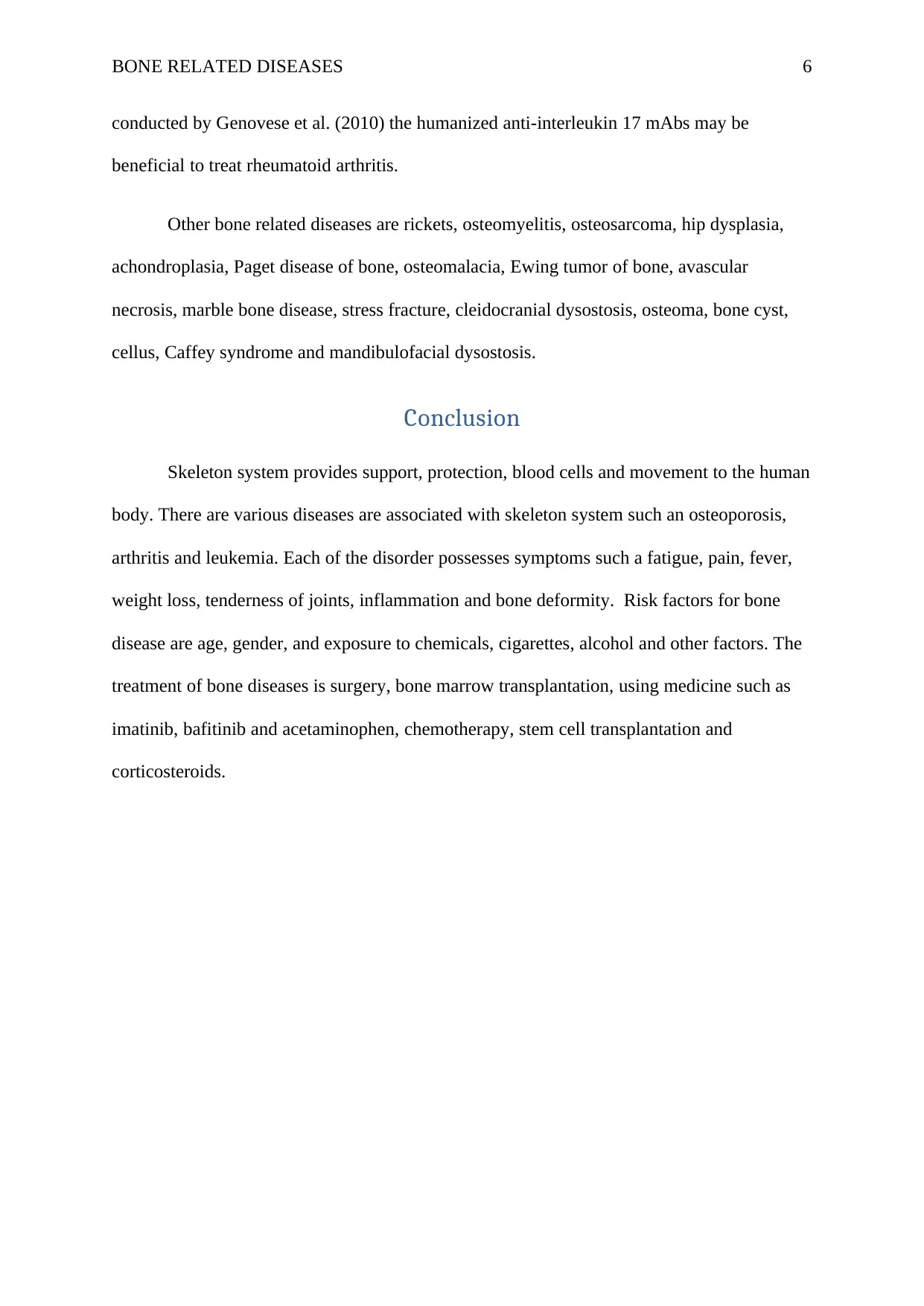
BONE RELATED DISEASES 6
conducted by Genovese et al. (2010) the humanized anti-interleukin 17 mAbs may be
beneficial to treat rheumatoid arthritis.
Other bone related diseases are rickets, osteomyelitis, osteosarcoma, hip dysplasia,
achondroplasia, Paget disease of bone, osteomalacia, Ewing tumor of bone, avascular
necrosis, marble bone disease, stress fracture, cleidocranial dysostosis, osteoma, bone cyst,
cellus, Caffey syndrome and mandibulofacial dysostosis.
Conclusion
Skeleton system provides support, protection, blood cells and movement to the human
body. There are various diseases are associated with skeleton system such an osteoporosis,
arthritis and leukemia. Each of the disorder possesses symptoms such a fatigue, pain, fever,
weight loss, tenderness of joints, inflammation and bone deformity. Risk factors for bone
disease are age, gender, and exposure to chemicals, cigarettes, alcohol and other factors. The
treatment of bone diseases is surgery, bone marrow transplantation, using medicine such as
imatinib, bafitinib and acetaminophen, chemotherapy, stem cell transplantation and
corticosteroids.
conducted by Genovese et al. (2010) the humanized anti-interleukin 17 mAbs may be
beneficial to treat rheumatoid arthritis.
Other bone related diseases are rickets, osteomyelitis, osteosarcoma, hip dysplasia,
achondroplasia, Paget disease of bone, osteomalacia, Ewing tumor of bone, avascular
necrosis, marble bone disease, stress fracture, cleidocranial dysostosis, osteoma, bone cyst,
cellus, Caffey syndrome and mandibulofacial dysostosis.
Conclusion
Skeleton system provides support, protection, blood cells and movement to the human
body. There are various diseases are associated with skeleton system such an osteoporosis,
arthritis and leukemia. Each of the disorder possesses symptoms such a fatigue, pain, fever,
weight loss, tenderness of joints, inflammation and bone deformity. Risk factors for bone
disease are age, gender, and exposure to chemicals, cigarettes, alcohol and other factors. The
treatment of bone diseases is surgery, bone marrow transplantation, using medicine such as
imatinib, bafitinib and acetaminophen, chemotherapy, stem cell transplantation and
corticosteroids.
Paraphrase This Document
Need a fresh take? Get an instant paraphrase of this document with our AI Paraphraser
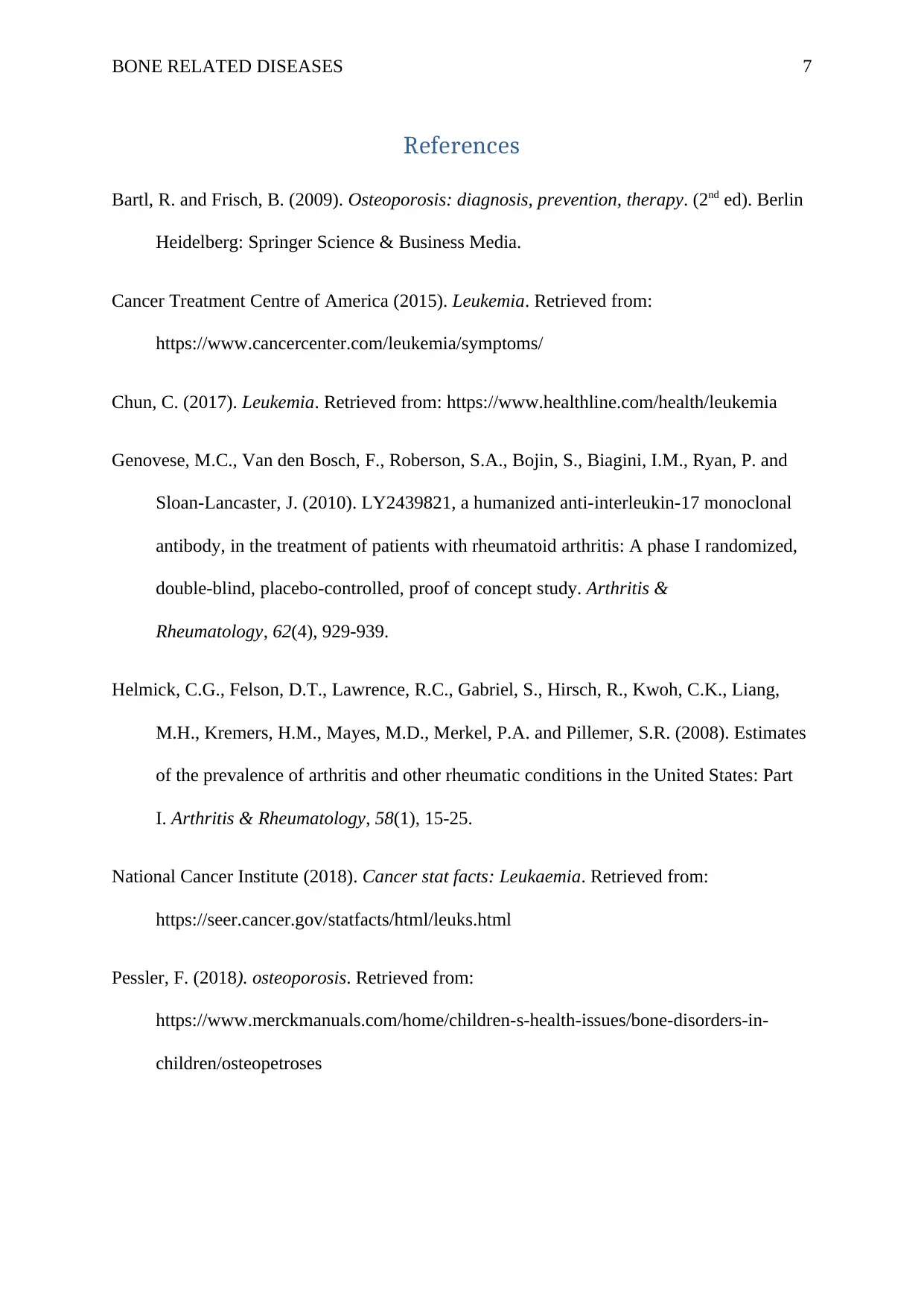
BONE RELATED DISEASES 7
References
Bartl, R. and Frisch, B. (2009). Osteoporosis: diagnosis, prevention, therapy. (2nd ed). Berlin
Heidelberg: Springer Science & Business Media.
Cancer Treatment Centre of America (2015). Leukemia. Retrieved from:
https://www.cancercenter.com/leukemia/symptoms/
Chun, C. (2017). Leukemia. Retrieved from: https://www.healthline.com/health/leukemia
Genovese, M.C., Van den Bosch, F., Roberson, S.A., Bojin, S., Biagini, I.M., Ryan, P. and
Sloan-Lancaster, J. (2010). LY2439821, a humanized anti-interleukin-17 monoclonal
antibody, in the treatment of patients with rheumatoid arthritis: A phase I randomized,
double-blind, placebo-controlled, proof of concept study. Arthritis &
Rheumatology, 62(4), 929-939.
Helmick, C.G., Felson, D.T., Lawrence, R.C., Gabriel, S., Hirsch, R., Kwoh, C.K., Liang,
M.H., Kremers, H.M., Mayes, M.D., Merkel, P.A. and Pillemer, S.R. (2008). Estimates
of the prevalence of arthritis and other rheumatic conditions in the United States: Part
I. Arthritis & Rheumatology, 58(1), 15-25.
National Cancer Institute (2018). Cancer stat facts: Leukaemia. Retrieved from:
https://seer.cancer.gov/statfacts/html/leuks.html
Pessler, F. (2018). osteoporosis. Retrieved from:
https://www.merckmanuals.com/home/children-s-health-issues/bone-disorders-in-
children/osteopetroses
References
Bartl, R. and Frisch, B. (2009). Osteoporosis: diagnosis, prevention, therapy. (2nd ed). Berlin
Heidelberg: Springer Science & Business Media.
Cancer Treatment Centre of America (2015). Leukemia. Retrieved from:
https://www.cancercenter.com/leukemia/symptoms/
Chun, C. (2017). Leukemia. Retrieved from: https://www.healthline.com/health/leukemia
Genovese, M.C., Van den Bosch, F., Roberson, S.A., Bojin, S., Biagini, I.M., Ryan, P. and
Sloan-Lancaster, J. (2010). LY2439821, a humanized anti-interleukin-17 monoclonal
antibody, in the treatment of patients with rheumatoid arthritis: A phase I randomized,
double-blind, placebo-controlled, proof of concept study. Arthritis &
Rheumatology, 62(4), 929-939.
Helmick, C.G., Felson, D.T., Lawrence, R.C., Gabriel, S., Hirsch, R., Kwoh, C.K., Liang,
M.H., Kremers, H.M., Mayes, M.D., Merkel, P.A. and Pillemer, S.R. (2008). Estimates
of the prevalence of arthritis and other rheumatic conditions in the United States: Part
I. Arthritis & Rheumatology, 58(1), 15-25.
National Cancer Institute (2018). Cancer stat facts: Leukaemia. Retrieved from:
https://seer.cancer.gov/statfacts/html/leuks.html
Pessler, F. (2018). osteoporosis. Retrieved from:
https://www.merckmanuals.com/home/children-s-health-issues/bone-disorders-in-
children/osteopetroses
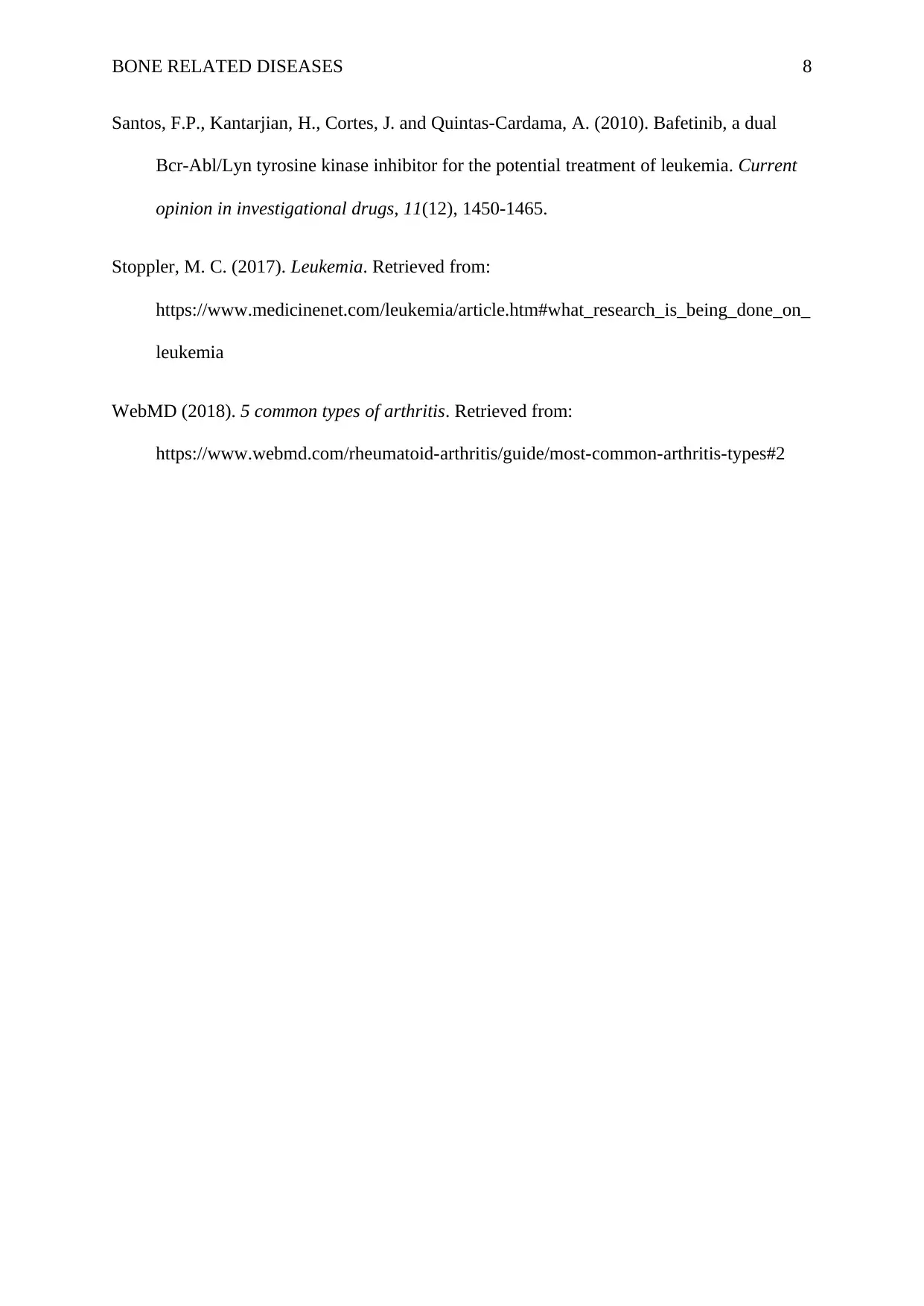
BONE RELATED DISEASES 8
Santos, F.P., Kantarjian, H., Cortes, J. and Quintas-Cardama, A. (2010). Bafetinib, a dual
Bcr-Abl/Lyn tyrosine kinase inhibitor for the potential treatment of leukemia. Current
opinion in investigational drugs, 11(12), 1450-1465.
Stoppler, M. C. (2017). Leukemia. Retrieved from:
https://www.medicinenet.com/leukemia/article.htm#what_research_is_being_done_on_
leukemia
WebMD (2018). 5 common types of arthritis. Retrieved from:
https://www.webmd.com/rheumatoid-arthritis/guide/most-common-arthritis-types#2
Santos, F.P., Kantarjian, H., Cortes, J. and Quintas-Cardama, A. (2010). Bafetinib, a dual
Bcr-Abl/Lyn tyrosine kinase inhibitor for the potential treatment of leukemia. Current
opinion in investigational drugs, 11(12), 1450-1465.
Stoppler, M. C. (2017). Leukemia. Retrieved from:
https://www.medicinenet.com/leukemia/article.htm#what_research_is_being_done_on_
leukemia
WebMD (2018). 5 common types of arthritis. Retrieved from:
https://www.webmd.com/rheumatoid-arthritis/guide/most-common-arthritis-types#2
⊘ This is a preview!⊘
Do you want full access?
Subscribe today to unlock all pages.

Trusted by 1+ million students worldwide
1 out of 9
Related Documents
Your All-in-One AI-Powered Toolkit for Academic Success.
+13062052269
info@desklib.com
Available 24*7 on WhatsApp / Email
![[object Object]](/_next/static/media/star-bottom.7253800d.svg)
Unlock your academic potential
Copyright © 2020–2025 A2Z Services. All Rights Reserved. Developed and managed by ZUCOL.





